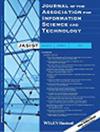Predicting the effectiveness of naïve data fusion on the basis of system characteristics
Journal of the American Society for Information Science and Technology
Pub Date : 2000-11-01
DOI:10.1002/1097-4571(2000)9999:9999%3C::AID-ASI1030%3E3.0.CO;2-E
引用次数: 92
Abstract
Effective automation of the information retrieval task has long been an active area of research, leading to sophisticated retrieval models. With many IR schemes available, researchers have begun to investigate the benefits of combining the results of different IR schemes to improve performance, in the process called “data fusion.” There are many successful data fusion experiments reported in IR literature, but there are also cases in which it did not work well. Thus, if would be quite valuable to have a theory that can predict, in advance, whether fusion of two or more retrieval schemes will be worth doing. In previous study (Ng & Kantor, 1998), we identified two predictive variables for the effectiveness of fusion: (a) a list‐based measure of output dissimilarity, and (b) a pair‐wise measure of the similarity of performance of the two schemes. In this article we investigate the predictive power of these two variables in simple symmetrical data fusion. We use the IR systems participating in the TREC 4 routing task to train a model that predicts the effectiveness of data fusion, and use the IR systems participating in the TREC 5 routing task to test that model. The model asks, “when will fusion perform better than an oracle who uses the best scheme from each pair?” We explore statistical techniques for fitting the model to the training data and use the receiver operating characteristic curve of signal detection theory to represent the power of the resulting models. The trained prediction methods predict whether fusion will beat an oracle, at levels much higher than could be achieved by chance.基于系统特性预测naïve数据融合的有效性
信息检索任务的有效自动化一直是一个活跃的研究领域,导致了复杂的检索模型。有了许多可用的红外方案,研究人员已经开始研究将不同红外方案的结果结合起来提高性能的好处,这一过程被称为“数据融合”。红外文献中报道了许多成功的数据融合实验,但也有不尽如人意的情况。因此,如果有一种理论能够提前预测两种或两种以上检索方案的融合是否值得进行,那将是非常有价值的。在之前的研究中(Ng & Kantor, 1998),我们确定了融合有效性的两个预测变量:(a)基于列表的输出不相似性度量,以及(b)两个方案性能相似性的成对度量。在本文中,我们研究了这两个变量在简单对称数据融合中的预测能力。我们使用参与TREC 4路由任务的红外系统来训练预测数据融合有效性的模型,并使用参与TREC 5路由任务的红外系统来测试该模型。该模型问道:“什么时候核聚变会比使用每对方案中最佳方案的预言机表现得更好?”我们探索了将模型拟合到训练数据的统计技术,并使用信号检测理论的接收器工作特性曲线来表示所得模型的功率。经过训练的预测方法预测核聚变是否会击败神谕,其水平远远高于偶然实现的水平。
本文章由计算机程序翻译,如有差异,请以英文原文为准。
求助全文
约1分钟内获得全文
求助全文
来源期刊
自引率
0.00%
发文量
0
审稿时长
3.5 months

 求助内容:
求助内容: 应助结果提醒方式:
应助结果提醒方式:


